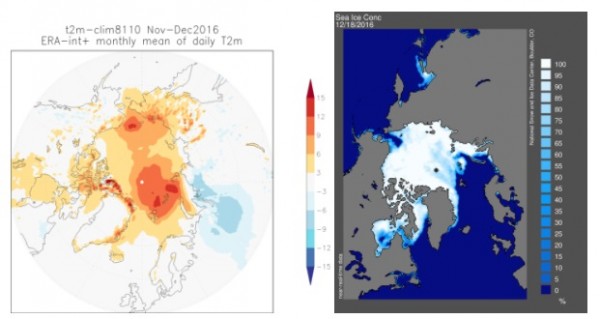By Ana Verayo, | December 23, 2016

a) Map of November-December temperature anomalies (ECMWF analysis & forecast up to Dec 25 compared to ERA-Interim, 1981-2010 climatology), b) December 18 sea ice concentrations. (NOAA/NSIDC)
For the second consecutive year, scientists predict that Arctic temperatures will continue to melt ice despite the fact that it is in the middle of the winter.
In the next few days, some regions of the Arctic Circle will experience warmer gusts of wind estimated to be 20 degrees Celsius hotter than normal during this time of the year, tipping over the melting temperature of water.
Like Us on Facebook
According to the US National Oceanographic and Atmospheric Administration (NOAA), over the next five days, some parts of the Arctic will be warmer than most of Canada.
These extreme warming temperatures during winter come alongside the lowest recorded sea ice levels, resulting in erratic and even violent weather patterns and systems especially in North America, Europe, and Asia.
This phenomenon in the Arctic region is known as "midwinter warming," according to climate scientists. A low-pressure system was detected in Greenland last year that constantly pulls in the warmer air in the region. Scientists say this has been happening more frequently due to disappearing winter sea ice as a result of climate change. With no ice sheets blocking this warm air, Arctic sea ice continues to melt even in winter.
According to climate scientist Andrew King from the University of Melbourne, these are very strange temperatures that are very near the freezing point, which is already warmer than usual temperatures in the Arctic, especially during winter.
Scientists also revealed that this year's November and December temperatures are 2.5 degrees Celsius warmer than usual during midwinter time, hitting another record.
In this new study, researchers from the University of Melbourne obtained evidence that these extreme average temperatures in the Arctic during winter are caused by climate change. They are considered as rare weather events that occur every 200 years. This is expected again by the year 2040 if the climate change trends continue.
By comparing two model simulations, one that consists of manmade greenhouse gas emissions and another one without it, the team was able to predict record temperatures this November and December in the Arctic.
The results revealed that this midwinter warming event would occur again during the 2040s, during an average of every second year.
-
Use of Coronavirus Pandemic Drones Raises Privacy Concerns: Drones Spread Fear, Local Officials Say

-
Coronavirus Hampers The Delivery Of Lockheed Martin F-35 Stealth Fighters For 2020

-
Instagram Speeds Up Plans to Add Account Memorialization Feature Due to COVID-19 Deaths

-
NASA: Perseverance Plans to Bring 'Mars Rock' to Earth in 2031

-
600 Dead And 3,000 In The Hospital as Iranians Believed Drinking High-Concentrations of Alcohol Can Cure The Coronavirus

-
600 Dead And 3,000 In The Hospital as Iranians Believed Drinking High-Concentrations of Alcohol Can Cure The Coronavirus

-
COVID-19: Doctors, Nurses Use Virtual Reality to Learn New Skills in Treating Coronavirus Patients







